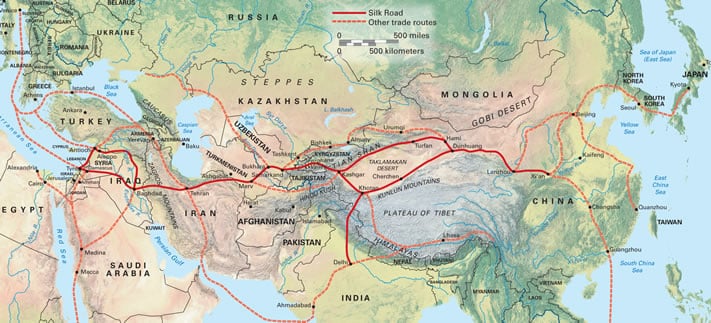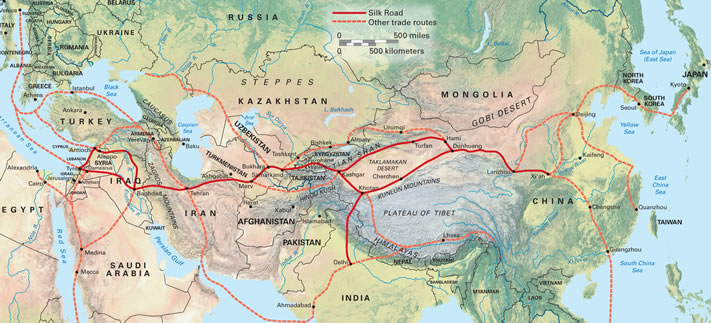Not even two years into what will almost certainly be a ten-year tenure as China’s president, Xi Jinping has already had an impact on China’s foreign policy: standing up for what many Chinese see as their nation’s territorial sovereignty in maritime boundary disputes in the East China Sea and the South China Sea, proposing a “new model of great power relations” to guide relations with the United States, and presiding over the consolidation of what Xi himself calls a “comprehensive strategic partnership” with Russia. But the most consequential diplomatic initiative of Xi’s presidency may turn out to be his calls to create a “New Silk Road Economic Belt” and a “Maritime Silk Road of the 21st Century”: vast infrastructure and investment schemes aimed at expanding China’s economic connections to—and its political influence across—much of Eurasia.
Successful implementation of Xi’s “one belt, one road” initiative is likely to be essential for China to meet some of its most pressing economic challenges. It is also likely to be critical to realizing the interest of many Chinese elites in a more “balanced” foreign policy—that is, in a diplomatic approach less reflexively accommodating of U.S. preferences—and in fostering a more genuinely multipolar international order.
Over 2,100 years ago, China’s Han dynasty launched what would become the original “Silk Road,” dispatching emissaries from the ancient capital of Xian in 138 BC to establish economic and political relations with societies to China’s west. For more than a millennium, the Silk Road of yore opened markets for silk and other Chinese goods as far afield as Persia—in the process extending Chinese influence across Central Asia into what Westerners would eventually come to call “the Middle East.”
In September 2013—just six months after becoming China’s president—Xi Jinping evoked this history in a speech at Kazakhstan’s Nazarbayev University by proposing the creation of a “New Silk Road Economic Belt” running from western China across Central Asia. The following month, addressing Indonesia’s parliament, Xi suggested developing a complementary “Maritime Silk Road” to expand maritime connections and cooperation between China and Southeast Asia.
Xi’s proposals sparked a torrent of expert deliberations, policy planning exercises across China’s ministerial apparatus, and public discussion. Through these efforts, the initial concepts of the “New Silk Road Economic Belt” and the “Maritime Silk Road” have been elaborated into an integrated vision for expanding China’s economic connections not just to Central and Southeast Asia, but across South Asia, the Persian Gulf, and the Middle East as well.
In recent months, Xi himself has laid out at least five major elements of this “one belt, one road” vision:
–A key aspect is the development of connective infrastructure—high-speed rail lines, roads and highways, even Internet networks—linking western China with central Asia and, ultimately, with points beyond such as Iran and Turkey, even going as far as Europe. In parallel, construction of ports and related facilities will extend China’s maritime reach across the Indian Ocean and, via the Suez Canal, into the Mediterranean basin. Over time, the New Silk Road Economic Belt and the Maritime Silk Road will be interwoven through channels like the projected China-Pakistan Economic Corridorand the Bangladesh-China-India-Myanmar Economic Corridor.
–This multifaceted development of connective infrastructure is meant to enable a second aspect of the “one belt, one road” strategy—expanding trade volumes between China and the vast Eurasian reaches to its West.
–Trade expansion will also be facilitated by a third aspect of the strategy—greater use of local currencies in cross-border exchange, facilitated by the growing number of currency swap arrangements between the People’s Bank of China and other national central banks. (In this regard, “one belt, one road” should reinforce Beijing’s ongoing campaign to promote renminbi as an international transactional and reserve currency.)
–Beyond these economic measures, a fourth aspect of the strategy emphasizes increased cultural exchange and people-to-people contact among countries involved in the “one belt, one road” project.
–Finally, the growth of cross-border exchange along the “New Silk Road Economic Belt” and “Maritime Silk Road” should be encouraged by intensified policy coordination among governments of participating states.
Economic Motives…
The drivers of China’s “one belt, one road” initiative are, first of all, economic. As a prominent Chinese academic economist puts it, the project is “a long-term macroscopic program of strategic development for the entire state.”
More specifically, a critical mass of political, policy, and business elites in China see the “one belt, one road” idea as critical to promoting more geographically balanced growth across all of China. Through thirty-five years of economic reform, development has been concentrated in the country’s eastern half. The New Silk Road Economic Belt, especially, is designed with a goal of jump-starting economic modernization in western China.
Beyond its impact inside China, the “one belt, one road” vision seeks to cultivate new export markets for Chinese goods and capital. For thirty-five years, advanced economies to China’s east—e.g., the United States and Japan—have been its most important economic partners and the most crucial outlets for its exports. Looking ahead, though, Chinese policymakers recognize that the potential for further growth in these markets is considerably smaller than in earlier phases of reform; they believe that, to compensate, China must nurture new export markets to its west.
Chinese analysts say that the territory encompassed by the New Silk Road Economic Belt and the Maritime Silk Road contains 4.4 billion people (63 percent of the world’s population), with an aggregate GDP of $2.1 trillion (29 percent of the world’s aggregate wealth). But, for this zone to play the economic role envisioned by Chinese leaders, it is necessary to encourage development not only in western China, but in economies across Eurasia—another major goal of both the New Silk Road Economic Belt and the Maritime Silk Road. It also means that, to be economically sustaining, these initiatives cannot be limited to areas contiguous to China. They must extend further westward, to include already more developed markets in eastern and southern Europe.
…and Strategic Rationales
Alongside these economic motives, Chinese interlocutors acknowledge that there are powerful strategic rationales for the “one belt, one road” approach. Certainly, the approach reflects Chinese leaders’ awareness of their country’s growing political as well as economic power; it also reflects the deepening of Chinese interests in strategically important regions to its west (e.g., the Persian Gulf).
In a regional context, the New Silk Road Economic Belt and Maritime Silk Road—like China’s recent championing of the Conference on Interaction and Confidence-Building in Asia in the security sphere and its leadership on creating an Asian Infrastructure Investment Bank—reflect Beijing’s increasingly evident assessment that Asian affairs should be managed more decisively by Asians themselves, not by extra-regional actors like the United States. More particularly, Chinese policymakers have framed their “one belt, one road” initiative as a response to the Obama administration’s much-hyped “pivot to Asia.”
Besides specific redeployments of U.S. military forces associated with American strategic rebalancing, Chinese elites increasingly see the United States engaged in economic, political, and military initiatives aimed at containing China’s rise as a legitimately influential player, in the Asia-Pacific region and globally. Sino-American rapprochement in the 1970s required Washington to abandon a failed quest for Asian hegemony, to realign relations with Beijing based on mutual accommodation of each side’s core interests, and to accept a more balanced distribution of power in Asia. Now, the United States appears to be backing away from these commitments and looking for ways to reassert a more traditionally hegemonic stance in Asia.
In the face of these trends, China is seeking to meet U.S. efforts to contain it to its east by expanding its diplomatic and political engagement to its west—including to areas like the Persian Gulf that Washington has long considered vital to America’s global position. To be sure, Beijing continues to rule out the possibility of military confrontation with the United States as in no way a rational prospect. But it also continues to seek a long-term transformation in the character of contemporary international relations—from an international system still shaped in large measure by unipolar American dominance to a more genuinely multipolar international order. To this end, the “one belt, one road” project could—if handled adroitly—prove a non-military catalyst that accelerates the relative decline of U.S. hegemony over the Persian Gulf and engenders a more balanced distribution of geopolitical influence in this strategically vital region.
Looking Ahead
Realizing the “one belt, one road” vision will pose serious and sustained tests for Chinese policymaking and diplomatic capabilities. Three such tests stand out as especially significant.
First, while one of the main motives for the New Silk Road Economic Belt is to encourage the development of western China—including the country’s Muslim-majority Xinjiang province—the Chinese government is increasingly concerned about the rising incidence of radicalization among some elements of Xinjiang’s Uighur Muslim population. Will Beijing be able to balance such concern against the imperatives of deepening China’s engagement with states in Central Asia, the Middle East, and other parts of the Muslim world?
Second, while “comprehensive strategic partnership” with Russia continues to be a prominent element in Chinese foreign policy, Moscow remains wary about any prospective increase in Chinese influence in former Soviet states whose participation is essential to implementing the “one belt, one road” approach. Will Beijing be able to maintain economically and strategically productive relations with Russia as it pursues this approach?
Third, while successful implementation of the New Silk Road and Maritime Silk Road initiatives can potentially contribute over the long term to a more balanced Sino-American relationship, getting them off the drawing board in anything more than preliminary fashion will almost certainly require Beijing to ignore U.S. displeasure on multiple fronts in the near-to-medium term.
A good example of this dynamic is how Chinese policymakers will engage Iran in the elaboration of the New Silk Road Belt and the Maritime Silk Road. Iran is comparatively unique among China’s prospective partners in that geography makes it important to the realization of both initiatives. Over the next few years, will Beijing continue to hold back from expanding economic and strategic cooperation with Tehran, in deference to U.S. preferences and (largely rhetorical) pressure? Or, to advance its “one belt, one road” vision, will China move more forthrightly to deepen relations with the Islamic Republic?
Trade-offs like these mean that how Beijing pursues this vision will almost certainly have a major bearing on the trajectory of Sino-American relations over the next decade and beyond. They also mean that Beijing’s relative success in forging a new Silk Road will do much to determine the extent to which China’s rise actually correlates with the emergence of a more truly multipolar international order in the 21st century.
Reprinted with permission from GoingtoTehran.com.


